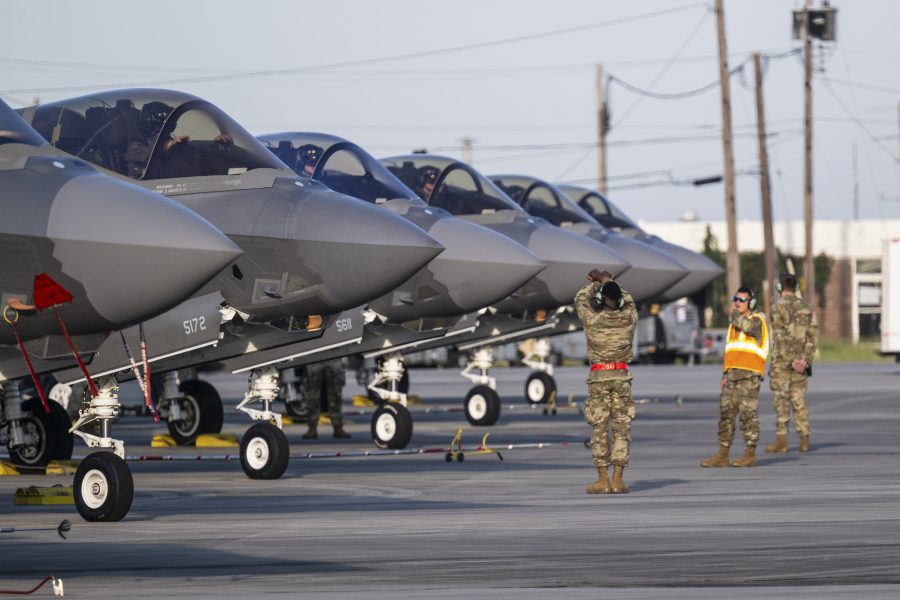Rumored cuts to the Pentagon’s F-35 buy in its fiscal year 2025 budget request would not be mitigated by recent Foreign Military Sales and are likely to drive prices higher, DOD and industry sources told Air & Space Forces Magazine.
The Department of Defense outlined plans to buy 83 F-35s in 2025 in its latest future years defense plan, but now the Air Force expects to cut six F-35As and the Navy eight F-35Cs, sources said.
If the proposed cuts go through, the Air Force would buy 42 F-35As; the Marine Corps would buy 16 F-35Bs, and the Navy would buy just 11 F-35Cs. However, sources cautioned that those numbers stem from leaked documents that may not be the final word on what the Pentagon will submit in its 2025 budget proposal next month.
Reuters previously reported on the possible cuts.
The Navy reduction would be hard to compensate for on Lockheed Martin’s production line, as those aircraft are already in work and there are no FMS customers for that variant to which the aircraft could be shifted. And while the Air Force “A-model” jets have more in common with many FMS customers, there are still dissimilarities among A-model users, such as drag chutes, which would cause churn on the assembly line and disrupt efficiencies.
Cutting the buy “drives a ton of inefficiency throughout the … whole production system,” an industry source said. “And then also drives that uncertainty amongst the suppliers. And they can re-price” parts, materials and assemblies “if the numbers aren’t the same. It’s just … a lot of turbulence and none of that turbulence helps price, schedule, or anything else.”
For the C-model aircraft there would have to be a “termination for convenience” of the government on a number of long-lead items already in work, an industry source said, which would likely drive overall prices higher.
Lockheed Martin designed its F-35 production facilities so that all variants move down the same assembly line, and an A model may be followed by two Cs and then a B, for example. The company has consistently rejected the idea of building large numbers of a single variant at a time, to maintain a learning curve with all variants and preserve some flexibility of manufacture.
While it might be possible to push some of the C-model long-lead parts into another contracted lot, generally, “a change in the quantities for a lot would have an impact on price,” the source said.
A Pentagon official acknowledged that cutting the buy “now, while we are in the middle of negotiations” on Lots 18 and 19 “sends the wrong demand signal” to suppliers, who will thus have to be cautious in quoting materials and component prices, given uncertainty about future work.
An industry source said 67 percent of Lockheed’s prices are set by the suppliers.
“It would be a fundamental change to the Lot 18-19 negotiation construct if they pull those jets out,” he said.
While the Navy may be able to put the cut F-35Cs on its Unfunded Priorities List, the Air Force may be enjoined within the DOD from taking that approach with its F-35As, sources said.
It’s wrong to assume that the unfunded aircraft can simply be transitioned to FMS customers, one observed. Even though the FMS customers may want their jets faster, “These countries … have very defined buy profiles that they have worked their national budgets for,” said one.
“They have the cashflow planned. And while it may be nice to pull it ahead a couple of years or a year to get a plane sooner, that may not have been what they were budgeted for. And most countries don’t have the budget flexibility to just decide to spend … a billion dollars earlier than planned,” he said.
Most customers also have a delivery profile tailored to the retirement of their existing equipment and the rate at which they can introduce the new airplanes, predicated on training pilots and maintainers and acquiring new ground equipment and weapons.
The Czech Republic, South Korea, and Israel have recently either made a deal to buy a collective 60 new F-35s or declared their desire to do so.
Cutting into the F-35 buy has become a convenient place to go for cuts, one industry source said, because it’s the largest aircraft program with thousands of units planned.
“People think they can shave some of it off and fix other problems,” he noted. “It’s not as straightforward as it seems.”
Lockheed Martin is storing some 60 F-35s, waiting for the Tech Refresh-3 upgrade to be tested before the jets can be delivered to the government. The rate at which those jets could be absorbed once the TR-3 is cleared isn’t likely to be a factor in the cuts contemplated. The reductions would affect Lot 19, and many of that lot’s aircraft won’t be delivered until 2027. One source familiar with the timing of the program said the TR-3 issue “hopefully, is long since in the rear-view mirror” by that point.
The F-35 is not the only area where cuts are being made in the 2025 budget, sources agreed. “There’s plenty of pain to go around,” noted one.
